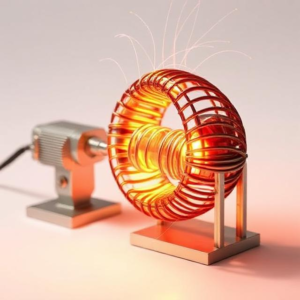Electromagnetic Induction is the process by which a changing magnetic field creates an electric current. It’s the foundation of many devices, including generators, transformers, and electric motors.
1. Faraday’s Law of Induction:
Faraday’s Law tells us how a changing magnetic field can create an electric current. Simply put, if a magnetic field changes, it can generate electricity.
- In simple terms: If you change a magnetic field, it creates an electric field, which can push electrons in a wire and create an electric current.
Imagine you have a coil of wire. If you move a magnet in and out of the coil or change the strength of the magnetic field around it, the movement or change in the magnetic field causes electrons in the wire to move, which creates a current. This is how power plants generate electricity by spinning turbines and creating changing magnetic fields.

Mathematically, Faraday’s Law is expressed as:
Where:
is the induced electromotive force (emf), or voltage,
is the magnetic flux (how much magnetic field is passing through the coil),
is the rate of change of the magnetic flux (how quickly the magnetic field changes).
In simple terms: The faster the magnetic field changes, the greater the voltage (electricity) created in the wire. This is why things like generators work: they constantly change the magnetic field around coils of wire to create electricity.
2. Lenz’s Law:
Lenz’s Law is a rule that tells us the direction of the induced current. It states that the direction of the induced current will always oppose the change that caused it. This is kind of like a protective mechanism that resists changes.
- In simple terms: The induced current in a loop of wire will try to oppose the magnetic field that caused it.
Let’s say you are moving a magnet toward a coil of wire. According to Lenz’s Law, the coil will produce a current that creates its own magnetic field, which will try to push the magnet away. This happens because nature tries to resist changes, like how friction tries to stop motion.
Why is this important?
Lenz’s Law ensures that energy is conserved in the process of electromagnetic induction. It also explains why you need to apply force to move magnets in generators—because the induced current creates a force that opposes the magnet’s movement.
3. Inductance:
Inductance is a property of a coil of wire that tells us how much voltage is induced in the coil when the current through it changes. In simpler terms, inductance measures how much a coil resists changes in current.
- In simple terms: If you change the current in a coil, the coil creates a voltage that resists that change. The bigger the coil or the more turns of wire it has, the more inductance it has.
When the current through a coil changes, it causes a change in the magnetic field around the coil. According to Faraday’s Law, this changing magnetic field induces a voltage in the coil. The inductance of a coil depends on factors like:
- The number of turns in the coil,
- The size of the coil,
- The material inside the coil (such as iron, which increases inductance).
Mathematically, inductance
is related to the induced voltage:
Where:
is the induced voltage,
is the inductance of the coil,
is the rate of change of the current.
In simple terms: Inductance resists changes in current. If you try to change the current flowing through a coil quickly, the coil will generate a voltage that opposes the change. This is why inductors (coils of wire) are used in circuits to smooth out changes in current, like in power supplies.
Summary:
- Faraday’s Law: A changing magnetic field creates an electric current. The faster the magnetic field changes, the greater the induced current.
- Lenz’s Law: The direction of the induced current will always oppose the change in the magnetic field that caused it, acting like a “resistor” to the change.
- Inductance: Inductance is a property of a coil that resists changes in current. The larger the coil or the more turns it has, the greater the inductance.
These concepts are key to understanding how devices like generators, transformers, and motors work. In a generator, for example, changing magnetic fields create electricity. In a motor, electricity is used to create changing magnetic fields, making things move.
Tags: AC generators, change in current, changing magnetic field, Circuit Components, coil of wire, coil size, core material, current regulation, direction of induced current, electric current generation, electric generator, electromagnetic devices, electromagnetic induction, electromechanical systems., electromotive force (emf), energy conservation, Faraday’s equation, Faraday’s Law, induced current, induced emf formula, induced voltage, inductance, inductors, iron core, Lenz’s Law, Lenz’s opposition, magnet motion, magnet-coil interaction, magnetic feedback, magnetic field opposition, magnetic flux, magnetic resistance, Maxwell’s equations in action, motor operation, number of turns, opposition to change, power generation, property of coil, rate of change of magnetic field, smoothing current, Transformer, turbine, voltage resistance


